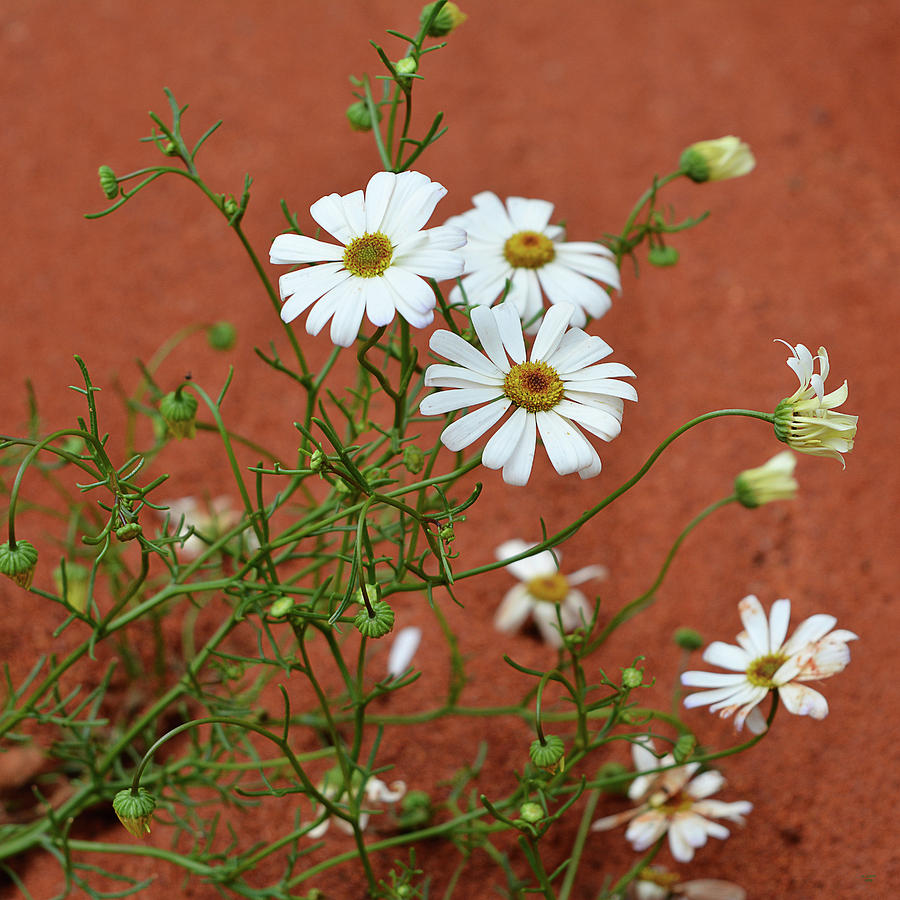
Branching Daisy aculeata) Common Australian native growing on dry or rocky hills
What about Australian native daisies? There are many but probably the best known are those that dry well and are used for floral decoration - the helichrysums and the helipterums. Like many other plants a lot of these have had a name change. Xerochrysum bracteatum Formerly Helichrysum bracteatum and Bracteantha bracteata.

Daisy, daisy how to grow native daisies for maximum impact Story 3 Australian Plants Society
Natural habitat The Paper Daisies that you see flowering at the Australian Botanic Garden Mount Annan during our Wildflower Festival are native to Western Australia, where they carpet huge expanses of some parts of the countryside in spring. History

Good Old Native Daisy multifida Mallee Design Australian garden design
Xerochrysum bracteatum, commonly known as the golden everlasting or strawflower, is a flowering plant in the family Asteraceae native to Australia. Described by Étienne Pierre Ventenat in 1803, it was known as Helichrysum bracteatum for many years before being transferred to a new genus Xerochrysum in 1990. It is an annual up to 1 m (3.3 ft) tall with green or grey leafy foliage.

Australian native daisies Front garden, Plants, Front yard
Swan River Daisies are found in the wild in WA, SA and southern NT in a variety of habitats: in sandy or clay soils, on sand-hills and plains, along water courses, on swampy ground, on chalky hills and among granite outcrops. They are moderately frost-hardy and can be grown easily in most areas of Australia.

The Yellow Everlasting Daisy 2 Australian Native Flower Photograph by Geraldine Cote Pixels
In Australia there are almost 1,000 indigenous species comprising shrubs, sub-shrubs, perennial herbs, annuals and a few biennials. There are too many Australian daisies to generalize about the growing conditions they enjoy. Some prefer full sun, others like shade, some like open conditions, others prefer overhead protection.

Australian native paper daisy Also commonly known as straw… Flickr
What daisies are native to Australia? Australia is home to several native daisy species. Some of the native daisies found in Australia include the Paper daisy (Rhodanthe chlorocephala) and Seaside daisy (Erigeron karvinskianus). You can find out more about both below. 13 daisies and how to grow them in your garden

White Swan River Daisy Australian Native Flower Photograph by Geraldine Cote Pixels
Australia has its own native type of daisy - the ever lovely Brachyscome. In our how to grow and care guide, we'll look at introducing the Brachyscome and some of the popular species that you find in Australia. Let's go through its propagation, care, and what pests and diseases to look out for. More. Brachyscome - Australian Native Growing Guide

Australian Native Pink Everlasting Daisy Flowers Xerochrysum Bracteatum Viewed From Above Also
Frequent pruning keeps its growth vigorous. Although most varieties are short-lived, they are easily propagated from cuttings. Brachyscome can be grown in most parts of Australia and can tolerate very shallow, sandy soils. Caring for native daisies. Both brachyscome daisies and bracteanthas can be grown in much the same way as other daisies.

Australian native red everlasting daisy flowers, Xerochrysum bracteatum. Also known as paper
Native daisies (species in the Asteraceae family) represent our second largest native plant group, surpassed only by the combined eucalyptus, melaleuca, callistemon, and leptospermum group that form the Myrtaceae family. All daisies have a unique structure. Each daisy is comprised of hundreds of tiny, individual flowers disguised as a single bloom.

The Essential Guide to Australian Native Plants News Ray White Inverloch
ADVERTISEMENT A Guide to the Native Daisies of Australia Did you know that there are around 1000 different species of daisies that are native to Australia? Written by: Annette Hird Last Updated: December 7, 2023

Australian Native Everlasting Daisy, Xerochrysum Bracteatum Stock Photo Image of meadow
Australian Plants - Daisies The Australian Daisy page contains descriptions and photos of some of these popular perennial herbaceous species including the popular Everlasting flower.

Australian native flowers everlasting daisies, paper daisies Native flowers, Garden plant
There are many stunning Australian native plants to choose from, here is a top 30 list of some of the most popular. 1. Australian daisy (Brachyscome) 2. Banksia (Banksias) 3. Bird's nest fern (Asplenium australasicum) 4. Bottlebrush (Callistemon) 5. Flame pea (Chorizema) 6. Cycad (Macrozamia) 7. Elkhorn and staghorn fern (Platycerium) 8.
australian native plants iberidifolia, Swan River Daisy
How to Grow Everlasting Daisies Everlasting Daisies are hardy, drought tolerant Australian native annuals, that are perfect for sowing from seed in April. The mixed hybrids in the Yates seed range are a colourful blend of red, white and pink semi double paper daisies. Full sun Frequent watering Well drained Autumn, Spring & Summer

These are Paper Daisies, an Australian native plant. I grew them from seed. r/gardening
Pelargonium australe, or the Austral Stork's-bill, is a native Australian plant that attracts butterflies and other pollinators with its bright flowers. It is an evergreen ground cover that grows to a height of 0.3 - 0.7 metres and a width of 0.5 - 1.5 metres, and it bears pink flowers in spring and autumn.

Paper daisy Australian National Botanic Gardens Photo S Sonntag Australian native plants
Brachyscome iberidifolia, also commonly known as the Swan River Daisy, is a native of Western Australia. This beautiful annual is a relatively short plant, growing to between 25-40 cm tall and 30cm wide. Flowers can be mauve, blue, white, purple, or even pink. The Brachyscome daisy makes for a fantastic native ground cover in Australian gardens.

GardenDrum C Stewart Australian native daisy GardenDrum
1. When to plant WA native daisies - plan for an April/May planting Seeds need to be planted soon after first rains in mid to late April/early May in Australia. The old adage of planting after Anzac Day is a good one. The germination of everlastings is governed by access to light, moist soil for more than three days and well-ripened seed.